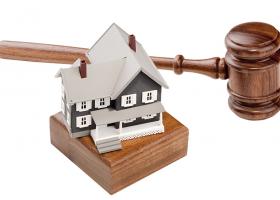Real Estate Terminology

Absentee owner
An owner who does not personally manage or reside at property owned.
Adverse Possession
A method of acquiring title to real property through the continued possession of the property under certain conditions for the statutory period by a person who is other than the owner of record.
Amortization
The period of time required to reduce a debt to zero when payments are made regularly. Amortization periods are most often 15, 20, or 25 years long.
Anniversary
Most lenders allow borrowers to make a payment on the anniversary of the mortgage. (For a mortgage assumed on June 1, a payment can be made every subsequent June 1 for the term of the mortgage.) It is applied against the principal and is a good way of reducing a loan.
Appraisal
A process that determines the market value of a property.
Appraised Value
An estimated value of a property that is completed by a certified appraiser for mortgage financing.
Approved Lender
A lending institution authorized by the Government of Canada to make loans under the terms of the National Housing Act. Only Approved Lenders can negotiate mortgages that require mortgage insurance.
Assumption
A legal document signed by a homebuyer that requires the buyer to assume responsibility for the obligations of a mortgage by the builder or original owner.
Balanced Market
Where demand for property equals the supply of available property. Sellers usually accept reasonable offers and houses generally sell in sufficient time periods. Prices remain stable and there is usually a good number of homes to choose from.
Blended Payment
A mortgage payment that includes principal and interest. It is paid regularly during the term of the mortgage. The payment total remains the same, although the principal portion increases over time and the interest portion decreases.
Building Permit A certificate that must be obtained from the municipality by the property owner or contractor before a building can be erected or repaired. It must be posted in a conspicuous place until the job is completed and passed as satisfactory by a municipal building inspector.
Buyer's Market
When there is a higher number of homes to choose from than buyers in comparison. Prices of homes tend to be lower and they remain available for sale longer. Buyers usually have more leverage in negotiating a purchase.
Closed Mortgage
A mortgage loan that has a locked-in payment schedule, which does not vary over the life of the closed term. A buyer who uses a closed mortgage will likely have to pay the lender a penalty if you fully repay the loan before the end of the closed term.
Closing Costs
Costs, in addition to the purchase price of a home, such as legal fees, transfer fees, and disbursements, that are payable on the closing date. Closing costs typically range from 2%-4% of a home's selling price.
Closing Date
The date on which the sale of a property becomes final.
CMHC
Canada Mortgage and Housing Corporation. A Crown corporation that administers the National Housing Act for the federal government and encourages the improvement of housing and living conditions for all Canadians. CMHC also creates and sells mortgage loan insurance products.
Collateral Mortgage
A mortgage that secures a loan by way of a promissory note. The money borrowed can be used to buy a property or can be used for another purpose, such as a home renovation or a vacation.
Commitment Letter / Mortgage Approval
Written notification from the mortgage lender to the borrower that approves the advancement of a specified amount of mortgage funds under specified conditions.
Conditional Offer / Conditions of Sale
An Offer to Purchase that is subject to specified conditions, for example, the arranging of a mortgage. There is usually a stipulated time limit within which the specified conditions must be met.
Conventional Mortgage
A mortgage loan up to a maximum of 75% of the lending value of the property. Mortgage loan insurance is not required for this type of mortgage.
Covenant
A clause in a legal document which, in the case of a mortgage, gives the parties to the mortgage a right or an obligation. For example, a covenant can impose the obligation on a borrower to make mortgage payments in certain amounts on certain dates. A mortgage document consists of covenants agreed to by the borrower and the lender.
Conveyancing
The transfer of ownership of any property or real estate from one person to another.
Deed
A legal document, which is signed by both the vendor and the purchaser transferring ownership. This document is registered as evidence of ownership.
Default
Failure to abide by the terms of a mortgage loan agreement. A failure to make mortgage payments, defaulting on the loan, may give cause to the mortgage holder to take legal action to possess (foreclose) the mortgaged property.
Deposit
A sum of money placed in trust by the purchaser when an Offer to Purchase is made typically. The real estate representative or lawyer holds the sum until the sale is closed, and then it is paid to the vendor.
Discharge of Mortgage
A document signed by the lender and given to the borrower when a mortgage loan has been repaid in full.
Down payment
The portion of the house price the buyer must pay up front from personal resources, before securing a mortgage. It generally ranges from 5%-25% of the purchase price.
Easement
A right acquired for access to or over, or for the use of, another person's land for a specific purpose, such as a driveway or public utilities.
Encumbrance
A registered claim for debt against a property, such as a mortgage.
Enforceable
A contract or agreement under which either party can be compelled to perform by a court of law or equity.
Equity
The difference between the price for which a home could be sold and the total debts registered against the home. Equity usually increases as the outstanding principal of the mortgage is reduced through regular payments. Market values and improvements to the property also affect equity.
FHLI
First Home Loan Insurance - This is a CMHC product of particular interest to people looking for their first home. It allows qualified first-time buyers to purchase a home with as little as 5% down. In these cases, CMHC will insure mortgages of up to 95% of the home's purchase price or the market value of the property, whichever is less. (Restrictions may apply. Contact your local lender.)
Financial leverage
The use of borrowed funds to acquire an investment.
Foreclosure
A legal procedure in which the lender gets ownership of the property if the borrower defaults on the mortgage loan.
Geographic Information System(s) (GIS)
System(s) (usually computer-based) used for capturing, handling, storing, retrieving,
managing, manipulating, and displaying geographic information or geo-coded data.
Gross Debt Service Ratio
The percentage of the borrower's gross income that will be used for monthly payments of principal, interest, taxes, heating costs, and half of any condominium maintenance fees.
High-Ratio Mortgage / Insured Mortgage Loan
A mortgage loan in excess of 75% of the lending value of the property. This type of mortgage must be insured - for example, by CMHC - against payment default.
Holdback
An amount of money withheld by the lender during construction of a house to ensure that construction is satisfactory at every stage. A standard holdback is 10% of the total cost of the building project.
Interest
The cost of borrowing money for a given period of time. Interest is usually paid to the lender in installments along with repayment of the principal loan amount.
Interest Adjustment Date (IAD)
A date from which interest on the mortgage advanced is calculated for regular payments. This date is usually one payment period before regular mortgage payments begin. Interest due between the date the mortgage is advanced and the IAD is due on closing.
Interest Rate
The rate at which you pay interest to the lender. For example, when the mortgage balance is $100,000, and the interest rate is 6 per cent, one single annual payment will include $6,000 interest. More frequent payments will result in different amounts.
iPro Realty
The brokerage for whom Oliver Reprich works, the head office is in Brampton, Ontario
Lending Value
The purchase price or appraised value of a property, whichever is less.
Loan-to-Value Ratio
The ratio of the loan to the lending value of a property expressed as a percentage. For example, the loan-to-value ratio of a loan for $25,000 on a home which costs $100,000 is 25%.
Lien (Mechanics)
A claim against a property for money owing. A lien may be filed by a supplier or a subcontractor who has provided labour or materials but has not been paid. A lien must be properly filed by a claimant. It has a limited life, prescribed by statutes that vary from province to province. If the lien holder takes action within the prescribed time, the homeowner may be obliged to pay the amount claimed by the lien holder. Alternatively, the lien holder may force a sale of the property to pay off the debt.
Maturity Date
The last day of the term of the mortgage agreement. On this day the mortgage loan must be paid in full or the agreement renewed.
Mortgage
Security for a loan to purchase property. It is the purchaser's personal guarantee to repay the loan and a pledge of the property as security for the loan.
Mortgage Life Insurance
Insurance to pay off your mortgage in full if you die. Many lenders offer this insurance and add the premium to your mortgage payments. However, you may want to compare rates for equivalent products from an insurance broker.
Mortgage Loan Insurance
Insurance required by lenders for high-ratio mortgages (more than 75% of the purchase price). It is available from CMHC or a private insurer for a cost of between 0.5% and 3% of the amount of the mortgage.
Mortgage Payment
A regularly scheduled payment that is blended to include both principal and interest.
Mortgagee
The lender who provides the mortgage loan.
Mortgagor
The borrower who pledges the property as security for the loan.
Net Worth
A person's total financial worth, calculated by subtracting total liabilities from assets.
NHA
Premium Insurance required by lenders for high-ratio mortgages (more than 75% of the purchase price). It is available from CMHC or a private insurer for a cost of between 0.5% and 3% of the amount of the mortgage. The premium can be added to your mortgage loan and paid off as part of your regular mortgage payments, or paid off in a lump sum at the time of purchase to save interest charges on the premium itself.
Offer to Purchase
A written contract setting out the terms under which the buyer agrees to buy. If accepted by the seller, it forms a legally binding contract subject to the terms and conditions stated in the document.
Open Mortgage
A type of mortgage loan where the borrower can make a partial or full payment of the principal amount at any time, without penalty.
Option Agreement
A document stipulating that, in exchange for a deposit, a specified individual is to be given the first chance to buy a property at or within a specified period of time. An option holder who does not buy at or within the specified period loses the deposit and the agreement is cancelled.
P.I.T.
Principal, Interest, and Taxes - payments due on a regular basis under the terms of a mortgage agreement. Generally, payments are made monthly and include one-twelfth of the estimated annual municipal and school taxes. Since these taxes change from year to year, this section of the mortgage will change accordingly.
P.I.T.H.
Principal, Interest, Taxes, and Heating - costs used to calculate the Gross Debt Service ratio (GDS).
Portability
An option available on a mortgage that enables the mortgagor to take their current mortgage loan with them to another property without penalty.
Pre-Approved Mortgage
When a lender approves the potential mortgagor for a specified amount, based on how much money the lender is prepared to lend to the borrower. This allows buyers to shop for homes that they already know they can obtain financing for and not homes that are potentially too expensive, or out of the borrowers means to finance.
Prepayment Privileges
Allows the borrower to make voluntary payments on the mortgage loan, in addition to the regular, scheduled mortgage payments.
Principal
The amount of money borrowed.
Property Purchase or Land Transfer Tax
A toll paid to the provincial and/or municipal government(s) for transferring property to the buyer from the seller.
REALTOR®
A trademark name for a real estate representative who is a member of an organization of persons engaged in the business of buying and selling real estate, such as the Canadian Real Estate Association.
Refinance
To pay off a mortgage or other registered encumbrance and arrange for a new mortgage, sometimes with a different lender.
Regular Mortgage
With this type of mortgage, you pay between 10% and 25% of the cost of the home as a down payment. The remaining balance is the amount of the mortgage loan required. A high-ratio mortgage requires mortgage loan insurance. CMHC offers it for a premium of 0.5%-3% of the mortgage amount. This fee can be added to your mortgage payments or paid in full on closing.
Renewal
At the end of a mortgage term, the borrower re-negotiates the loan for a new term.
Second Mortgage
An additional mortgage on a property that already has a mortgage.
Seller's Market
More buyers are looking for homes than there are homes for sale. There is a smaller inventory of homes available for sale and many buyers looking to purchase. House prices generally increase and homes sell quickly.
Statement of Adjustment (s
A balance sheet statement that indicates credits to the vendor - for example, the purchase price - and any prepaid taxes and credits to the buyer, such as the deposit, and the balance due on closing.
Survey
A document that illustrates the property boundaries and measurements, specifies the location of buildings on the property, and indicates any easements or encroachments.
Term
The length of time during which a mortgagor pays a specific interest rate on the mortgage loan. The entire mortgage principal is usually not paid off at the end of the term because the amortization period is normally longer than the term.
Title (freehold or leasehold)
Legal possession. A freehold title gives the holder ownership of land and buildings for an indefinite period of time. A leasehold title gives the holder a right to use and occupy land and buildings for a defined period of time. In a leasehold arrangement, actual ownership of the land, sometimes along with the buildings, remains with the landlord.
Total Debt Service Ratio (TDS)
The percentage of gross annual income required to cover all payments for housing and all other debts, such as car payments.
Variable-rate Mortgage
A type of mortgage with fixed payments but fluctuating interest rates. The change in current interest rates doesn't alter the amount of the mortgage payment, but determines how much of each payment is applied against the principal amount and how much goes to pay interest to the lender.
Vendor Take-Back Mortgage
Mortgage financing arranged between the seller of the property and the buyer. Often this type of loan is a second mortgage, which the seller is willing to arrange at below market rates to allow the buyer to purchase the house. Most of these arrangements are not renewable or transferable to the next owner of the house.
Zoning Bylaws
Municipal or regional laws that specify or restrict land use.













